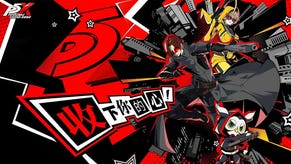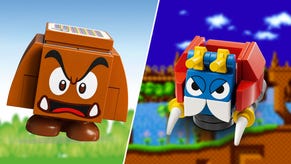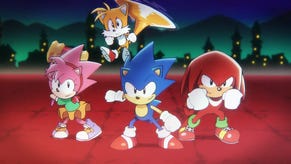Sonic the Hedgehog – 20th Anniversary Special
Sonic the Hedgehog turns a full score today. Stace Harman's looks back at the Sega mascot's trials, tribulations and deathmatch against some weird plumber bloke.
Back in the day
Sonic owes me a family BBQ.
It started for me way back when two of today’s ‘big three’ platform holders were still making portable cassette players and computer operating systems. Back when it looked like Sega’s home consoles would be around forever.
Having stayed at a friend’s house in the summer of 1991 I was up early on a Sunday morning, zooming this way and that, determined to finish this awesome new game with its unbelievably catchy intro music and the clear pronunciation of a brand name than ended dozens of playground arguments (“It’s Say-ga not See-ga, div”). I spent six hours playing the game on that sunny Sunday - these being the days when game save features were a luxury and if you wanted to finish a game you made use of a handful of continues and knuckled down.
Six hours and three phone calls to my parents later and I could delay my inevitable departure no longer. It was time to go. I left dejected, Sonic glaring at me and tapping his foot, waiting to be told where to go next. Come to think of it, I suspect I may have been a little bit rubbish at games back then.
Of course, when he wasn’t getting small kids in trouble with their parents, Sonic’s primary function was to provide a counterpoint to one Mr Mario.
The Golden (ring) Days
Back in the late 80s and very early 90s - when we still had proper names for decades – Nintendo was riding high. Despite Sega beating its Japanese counterpart to market by a good two years in its domestic and US markets with its 16-bit offering, the Sega Mega Drive/Genesis, Nintendo had something that Sega did not have. Nintendo had an icon and that icon had starred in one of the most highly regarded platform games ever made: Super Mario Bros 3.
Sega, on the other hand had Alex Kidd.
And so, Sega’s AM8 division – later renamed Sonic Team – was tasked with creating a mascot to rival Mario. In fact, at the time it felt like they had created a force of nature. One to epitomise the speed with which Sega’s hardware could move and with which they hoped to steal the limelight from Nintendo’s Super Mario World.
Created by some now-famous names – character designer Naoto Oshima, level designer Hirokazu Yasuhara and programming whizz Yuji Naka – Sonic was, according to gaming folklore, very nearly an armadillo or a squirrel. Fortunately, the desire for a spiky protagonist led to the eventual hedgehog design and Sonic’s first game was released on 23rd June 1991, in the US and Europe.
The antithesis of Mario’s relatively sedate pace and slightly podgy appearance, Sonic was sleek and svelte. Gormless Goombas were trumped by trapped animals in malicious robotic casings. Sonic looked at you and tapped his foot if you left him idle for too long, he didn’t jump on enemies, he jumped through them and he had what is one of the most iconic opening levels of any videogame ever. And he was cool. Sonic the Hedgehog replaced Altered Beast as the game packed with the Mega Drive and the system sold and sold and then sold some more. Sega finally had its mascot - he was even decked out in family livery of blue and white, and dapper red trainers.
Sonic’s level design was deliberately designed for establishing racing lines, for seldom backtracking and for showing off the tight control scheme. Its special stages, however – reached by finishing a level with over 50 gold rings - were a tense, 360 degree bumper-laden labyrinthine nightmare that robbed you of Sonic’s usual responsiveness and tasked you with avoiding the exit until you’d obtained the Chaos Emerald. Obtain all six emeralds and you completed the game ‘properly’.
Sequels. Lots of sequels.
Sonic the Hedgehog 2 arrived the very next year in 1992 – on ‘Sonic 2sday’ – and, in a bid to 1-up Mario’s ‘take it in turns 2-player mode’ it introduced Tails, a mutated looking fox with two tails, for split-screen two-player action. Building on the concepts of the first game, Sonic was made faster, had a new dash attack and the special stages were more visually impressive - though less tense – taking the form of a 3D half-pipe in which Sonic had to collect an increasing number of rings as he passed through three check points; collecting the requisite number of rings unlocked the Chaos Emerald for collection.
Sonic 2 helped cement the Mega Drive as a 90’s powerhouse and helped it rival Nintendo’s installed base. In doing so, Sonic’s future success looked assured. A new gaming franchise had been minted and each new release was surely a thing to relish.
Unfortunately, small cracks began to appear with each new release. Sonic 3 and Sonic and Knuckles, although generally well received, were not a patch on the pure thrills and sublime design of the first two games. Where Mario games took on an aura of invincibility, the name itself becoming synonymous with quality, Sonic’s expanding roster additional characters and abilities coupled with the sheer number of sonic games released throughout the 90s, diluted Sonic’s pure – some would argue one-dimensional – appeal.
Sonic Vs Mario – The later years
With Sega’s fall from grace as a console manufacturer, and several mediocre Sonic titles on the market, Sega was free to buddy up with its old nemesis and in a move that our playground selves would have scoffed at a released Sonic and Mario at the Olympic games, and the Winter Olympics. And again in Super Smash Bros. Brawl.
Despite the recent string of lacklustre 3D titles the franchise has shown some fighting spirit with its 2010 return to 2D goodness in Sonic the Hedgehog 4: Episode 1. I still have hope that the blue one will get back to his best. That his return to his pure twitch gaming roots will be complete by the time the next entry in the series rolls around, or maybe the next one after that.
And so I never did finish Sonic on that fateful day and I incurred the wrath of my parents for being late to the BBQ but it’s OK, I forgive him. Sonic Generations is looking like it might, just might, turn back the clock and, who knows, maybe I’ll be convinced to miss another important family event.
Here’s hoping.




.jpg?width=291&height=164&fit=crop&quality=80&format=jpg&auto=webp)






